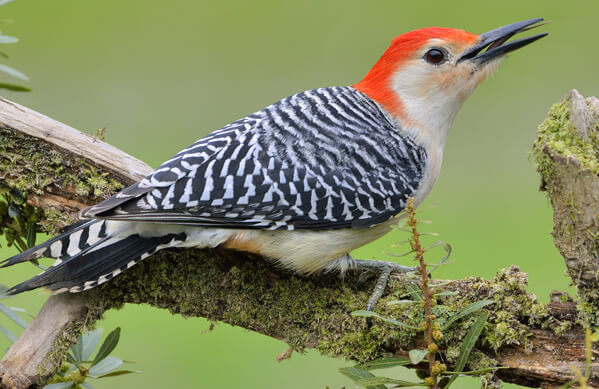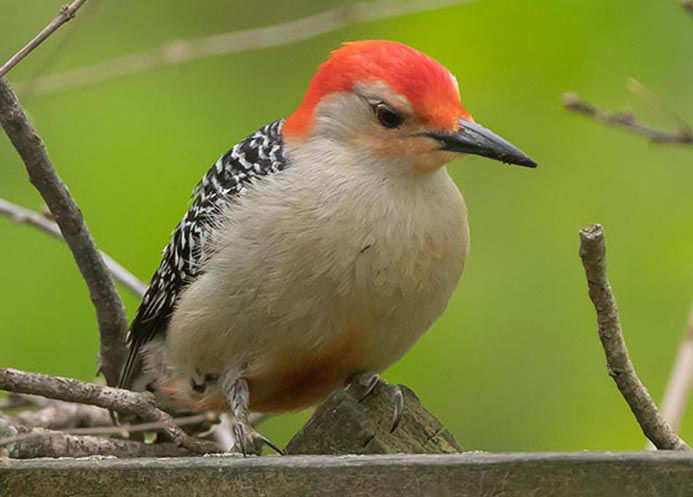Observing Woodpeckers in Florida: Types Diversity and Distribution
Observing Woodpeckers in Florida: Types Diversity and Distribution
Blog Article
Woodpeckers: A Comprehensive Guide to Recognizing These One-of-a-kind Birds
Woodpeckers, with their distinctive habits and physical qualities, have actually long astounded the inquisitiveness of ornithologists and nature lovers alike. From their rhythmic drumming echoing with the woods to their exceptional adjustments for scaling tree trunks with simplicity, these birds present a fascinating research in bird biology. What genuinely establishes woodpeckers apart is not just their striking appearance yet also their important function in keeping the fragile equilibrium of ecosystems. As we discover the complex anatomy, varied types, and eco-friendly relevance of woodpeckers, a deeper admiration for these special birds and the secrets they hold unfolds.

Woodpeckers' Drumming Actions
Woodpeckers show a balanced and exact drumming habits that serves numerous essential functions in their day-to-days live. This behavior is primarily associated with interaction, region protection, and foraging. The distinct drumming sound is created by the rapid pecking of their beaks versus difficult surfaces such as tree trunks, branches, and even steel things.
Interaction is a vital element of woodpecker habits, and drumming plays a significant role in this procedure. Woodpeckers utilize drumming to establish their presence, bring in companions, and preserve contact with their partners and spawn. The frequency, strength, and period of drumming sequences share certain messages to other woodpeckers in the location.
Along with interaction, woodpeckers utilize drumming actions for area defense. Woodpeckers in Florida. The loud and recurring drumming functions as a cautioning to possible trespassers, indicating that the area is currently declared. By developing their area through drumming, woodpeckers minimize the possibility of problems over important sources such as food and nesting sites
In addition, woodpeckers also use drumming as a foraging technique. The balanced pecking helps them situate insects concealing beneath the bark of trees by producing vibrations that interrupt the prey's cover-up. This actions showcases the adaptability and ingenuity of woodpeckers in utilizing their drumming skills for numerous essential functions.
Unique Adaptations for Tree Climbing
Having actually grasped the art of drumming to connect, safeguard region, and forage, woodpeckers have actually evolved distinct adjustments that promote their impressive climbing capabilities in their arboreal environments. Woodpeckers have zygodactyl feet, with two toes directing ahead and two toes directing backwards. These tail feathers offer security and balance, making it possible for woodpeckers to maneuver up tree trunks with precision and agility.
Furthermore, woodpeckers have powerful neck muscles and an unique skull framework that aid in their climbing abilities. Their solid neck muscular tissues permit them to swiftly peck at tree bark without experiencing whiplash, while their thick skull and small mind work as shock absorbers, securing them from the effect of repeated drumming. These adjustments jointly allow woodpeckers to navigate the upright globe of trees with performance Source and poise.

Duty of Woodpeckers in Communities
Playing a crucial role in woodland ecological communities, woodpeckers contribute significantly to the balance and health and wellness of their environments through their special actions and communications with other types. Among the crucial environmental features of woodpeckers is their role in controlling insect populations. By foraging for bugs under the bark of trees, woodpeckers aid manage pest populations, avoiding break outs that might hurt the total wellness of the woodland. In addition, woodpeckers create cavities in trees that work as important nesting websites for a range of various other bird varieties, promoting biodiversity within the ecosystem.
In addition, the drumming and articulations of woodpeckers play a crucial function in communication and territory facility. These audios not only serve to bring in friends however also help specify limits between different woodpecker regions, lowering problems and advertising a harmonious conjunction within the woodland neighborhood. Overall, the presence of woodpeckers in woodland environments highlights their significance as keystone species, influencing the characteristics and working of these habitats in complex methods.
Makeup: Specialized Beaks and Feet
In the elaborate internet of forest environments, the specialized beaks and feet of woodpeckers are vital adaptations that enable them to accomplish their important eco-friendly roles. Woodpeckers have unique anatomical attributes that are specifically created to assist them in their foraging and nesting habits.
One of the most distinguishing characteristic of woodpeckers is their solid, chisel-shaped beaks. recommended you read These beaks are perfectly adapted for boring right into wood to uncover insects, larvae, and sap surprise under the bark of trees. The solid muscle mass and strong framework of their beaks allow woodpeckers to peck at a rate of as much as 20 times per secondly without creating damage to their heads.
In addition, woodpeckers have actually specialized feet that aid in their acrobatic climbing capabilities. Their feet have 2 toes aiming onward and two toes pointing backwards, supplying a solid grasp on upright surfaces (Woodpeckers in Florida). This distinct foot visit this website arrangement, together with rigid tail plumes that work as an encouraging prop, permits woodpeckers to stick to tree trunks and branches with ease while they search for food or excavate nesting tooth cavities
Woodpecker Types Diversity
What aspects add to the exceptional variety of woodpecker varieties throughout various environments and areas? Woodpeckers are a varied group of birds discovered across various environments worldwide, with over 200 recognized types displaying adaptations to various settings. One crucial aspect driving this diversity is the accessibility of suitable habitats. Woodpeckers have actually advanced to live in a variety of atmospheres, from forests and forests to grasslands and deserts, each offering one-of-a-kind obstacles that have influenced the evolution of distinctive woodpecker types.
An additional adding factor to woodpecker species diversity is their specialized feeding behaviors. Various species have actually progressed to exploit numerous food sources, such as pests, tree sap, fruits, and nuts, leading to the growth of particular adjustments in beak shape, dimension, and strength. These adjustments enable woodpeckers to forage successfully in their respective environments, reducing competitors among types and advertising specific niche distinction. Additionally, geographical seclusion and historical aspects have contributed fit the circulation and variety of woodpecker types, resulting in the vast range of specialized adjustments seen in these fascinating birds.

Final Thought
In conclusion, woodpeckers are interesting birds that exhibit distinct drumming behavior, specialized adaptations for tree climbing, and play important roles in communities. With a varied range of woodpecker types located worldwide, these birds are vital for keeping the health and wellness and equilibrium of woodlands and forests.
Report this page